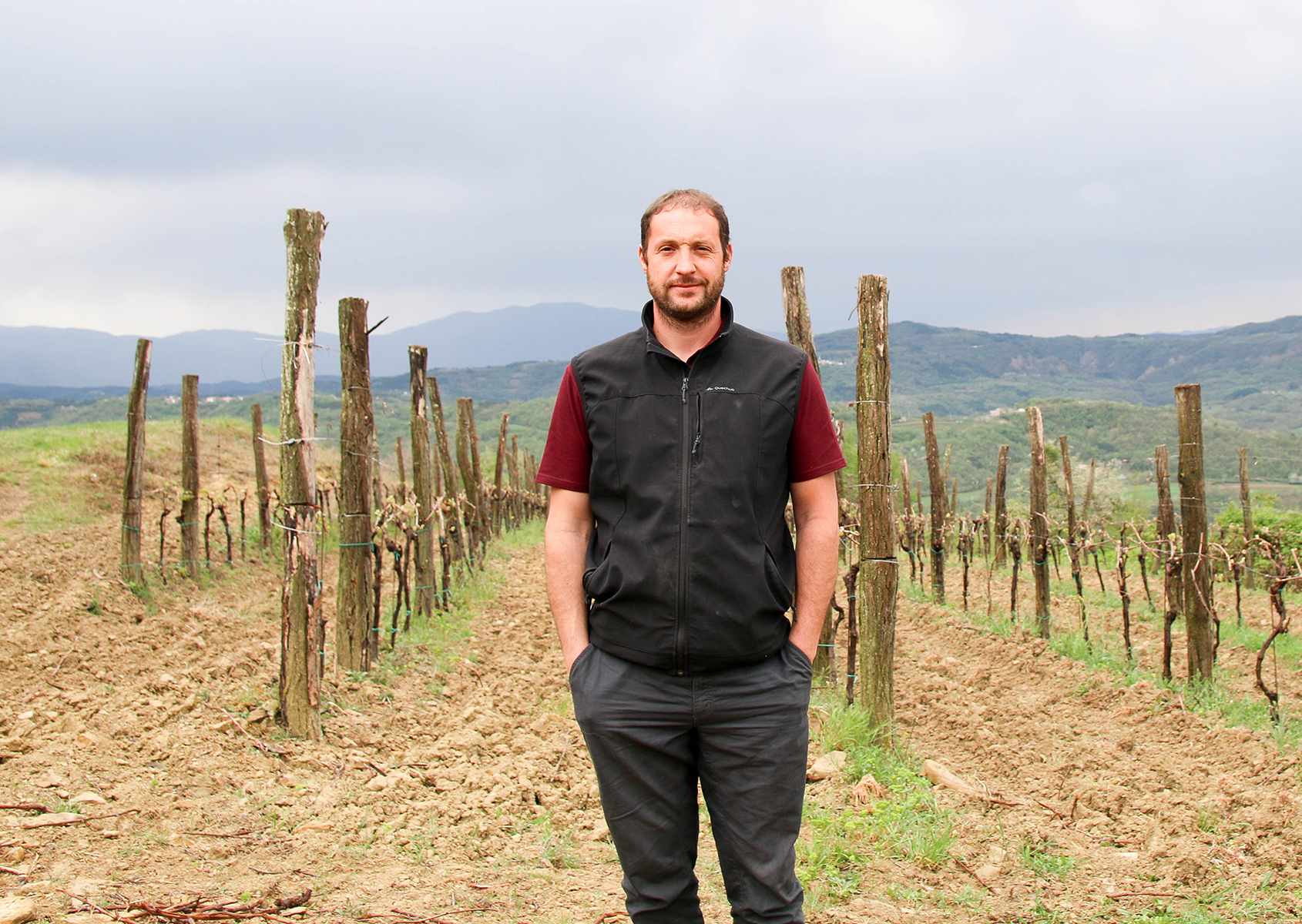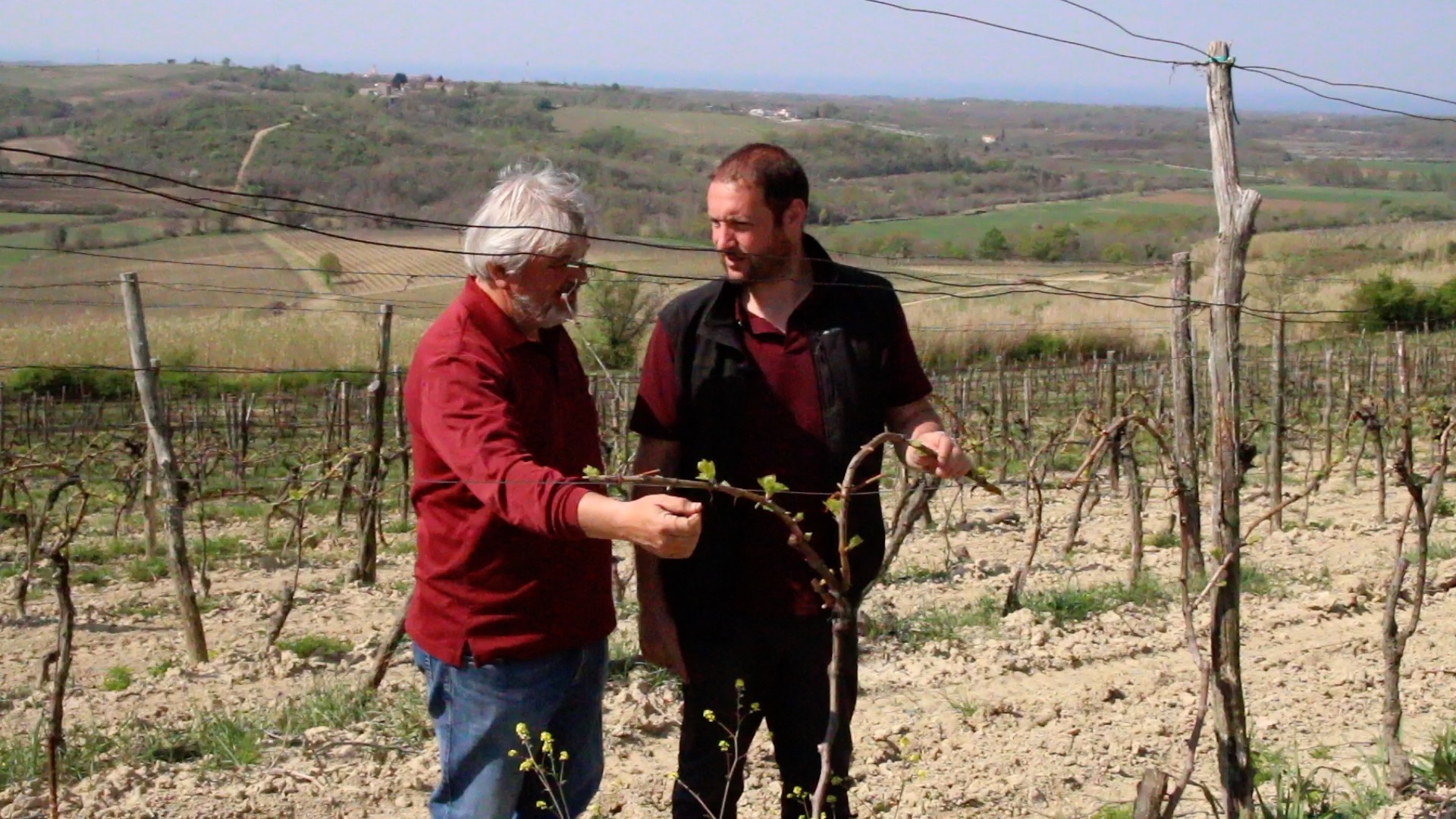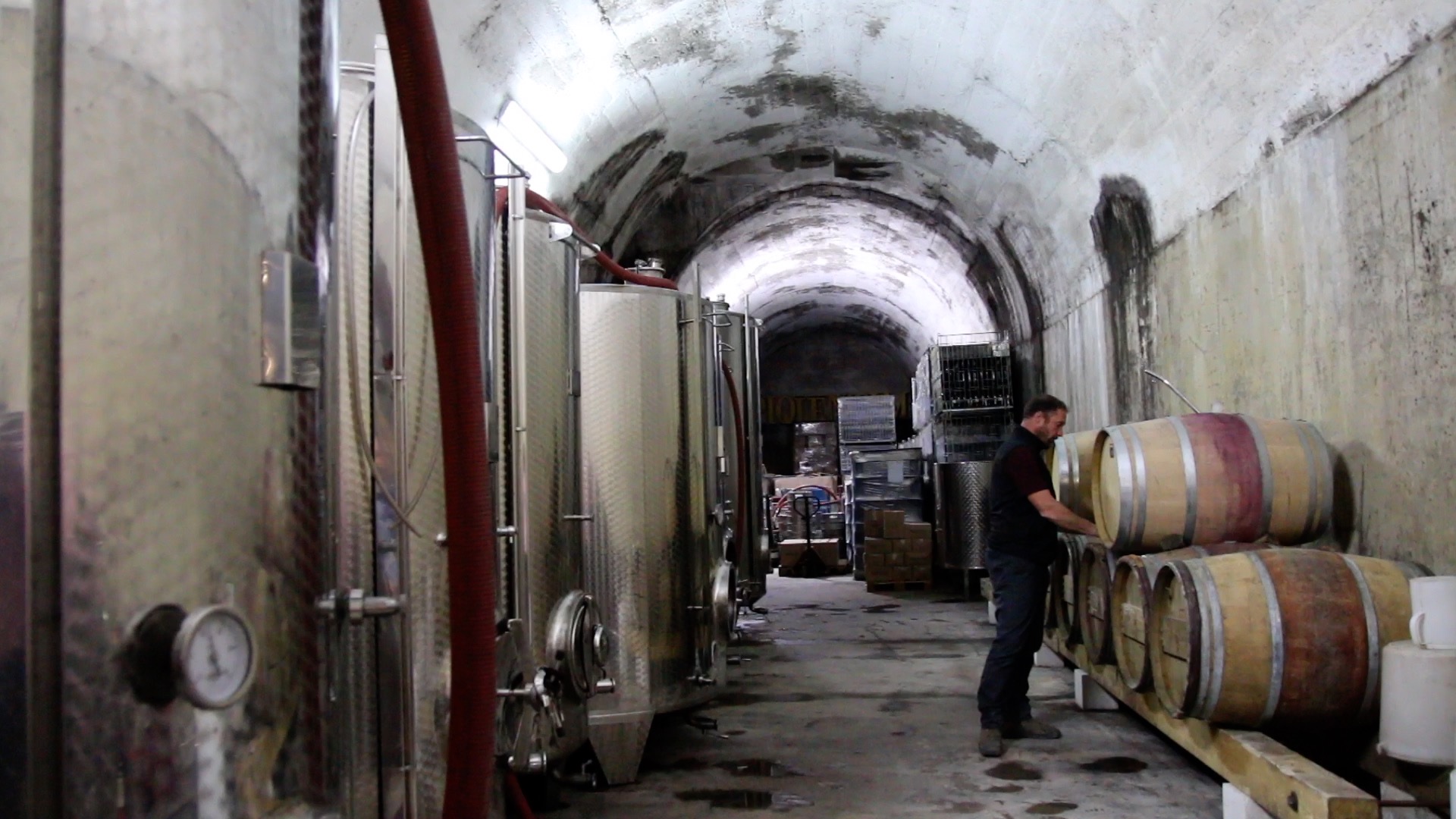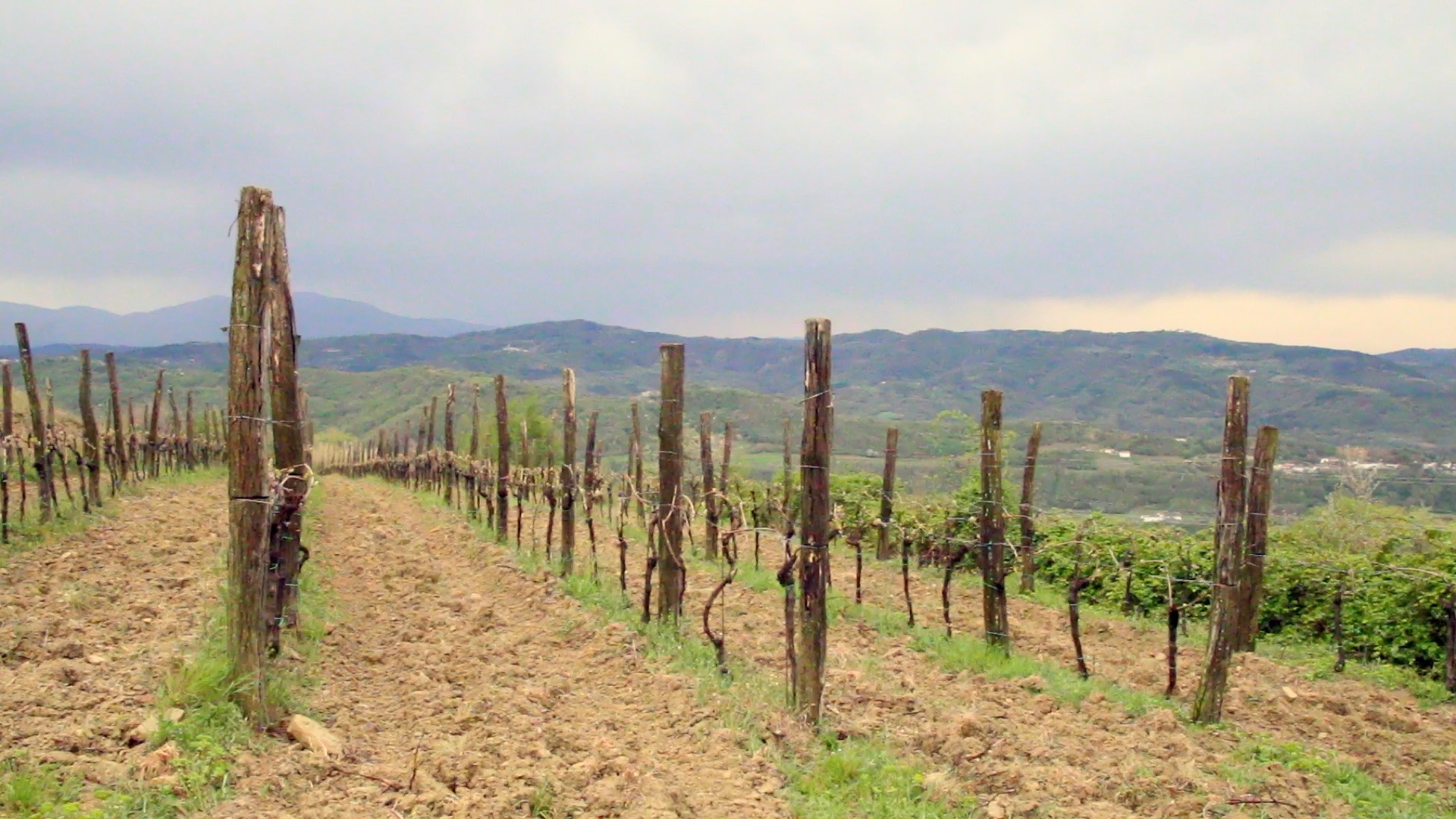
Piquentum is the passion project of French, Croatian winemaker Dimitri Brečević. Brečević was born in French Basque Country and studied winemaking in France and worked in Australia, New Zealand, Bordeaux, and Burgundy. In 2004 he moved to Istria (his father's homeland) to create his own winery.
Istria, a peninsula at the top end of the Dalmatian Coast, has great potential as a wine region. It boasts mineral-rich white and red Karst soils and unique indigenous grapes like Malvazija Istarska and Teran. Istria lies on the northern edge of the Adriatic, and the climate in the interior of Istria where Piquentum's vineyards are located has dry and hot Mediterranean days and cool nights. The winery is named “Piquentum” as it is the ancient Roman word for the hilltop town of Buzet where the winery sits.
Brečević practices a natural winemaking approach. Grapes are hand picked and pressed into concrete tanks without temperature control. All of Dimitri’s wines complete a wild ferment without the use of added yeast or any additives and bottled unfiltered with minimal sulfur. In addition to owning Piquentum, Brečević also manages operations at fellow Croatian natural winemaker Georgio Clai's estate.
Christopher Barnes: So Dimitri, how did you get involved in wine?
Dimitri Brečević: Well actually, I decided as a young guy to go to school for winemaking and wine growing. First, I decided I knew that I wanted to work in agriculture. Step by step, I began to realize that winemaking and wine growing were more suited for what I wanted to do. So I guess the influence was a little bit from my childhood here in Istria and also from my childhood in France where some of my mother's family were growing a vineyard.
 What part of France was that?
What part of France was that?
I was born in a small town called Jurançon. It's southwest of France. It's two hours from Bordeaux, half an hour from the Spanish border, and a small hour from the Atlantic coast.
What kind of wines were they making there?
White. Whites are very famous. It's one of the oldest AOCs in France for sweet wine. Very, very concentrated sweet wine. Of course, these last decades, because the sweet wine is more difficult, we started to make more and more, it was already traditional, but more and more dry white wine.
It's made from local varieties called Gros Manseng, Petit Manseng and Courbu. Varieties you can find just in that area, very specific.
Talk a little bit about your wine journey in Istria.
My wine journeys in Istria started 10 years ago when I decided to do my own production. I used to come here as a child and I always believed that Istria was a good land for winemaking. During my studies, I began to understand this more and more because I had more knowledge and more experiences. It definitely became a goal and as I said, 10 years ago, I came and I started with my own business here. I got a little bit of help from my father. He's Croatian, and from my friends also, and my brother. I started step by step like that.
Then you became involved with Giorgio Clai. How did that happen?
When I came here 10 or 11 years ago now, we had friend in common and this guy is a big, big fan of natural wines and organic wines. He introduced us, as he was already a friend of Giorgio Clai, and he quickly became my friend. He said, "Okay, let's do something all together where you can get to know each other." Very quickly I became friends with Giorgio. Friend means that we share many things like experiences and knowledge, enjoyment, parties, many bottles together. He's older than me, and his daughter and son didn't want to get into the business, so we decided to do something together.
Talk a little bit about the challenges in creating your own wine label, because it's not just the viticulture, is it? It's the going out and getting restaurants to take it when they've already got a lot of wine to choose from. It's a complicated thing running your own business.
It is. To be honest, I think at this time I was not so aware of all these things. I was 27 years old, I had this goal in my head, I really wanted to that. I really didn't take into consideration so many of the details, let's say. I had to learn about details, again step by step, again by force sometimes. I think when you believe in something, it sounds a little bit like a fairy tale now.
But it's not at all a fairy tale, it's very difficult, you pass through very difficult moments. Sometimes you want to leave everything and you want to abandon it. But when you believe in the product, there's always somebody who recognizes that and somebody who will help you. These last 10 years passed like this. Also, Giorgio is part of this help because he's a support for me, so having that somebody who also believes in what you do can be a great help. The rest come almost naturally. We've made some mistakes sometimes where you pay a lot, but again, the real thing is to believe in the project and the rest falls into place and organizes itself.
So Dimitri, let's talk about natural wine. You make wine in a noninterventionist way. You're using organic grapes. What are some of the challenges in making natural wine?
The biggest challenge is that with natural wine growing and winemaking, somehow there is no second chance. No second chance. Sometimes, maybe in a conventional way, maybe something is going wrong, and you can spray something a little bit harder or you can put some product in a wine maybe, I know. With natural wine growing and winemaking, there is nothing like that. You have one shot. That's it. Very often, of course, for myself it's like that. I'm really trying to push the limit, so, of course, very often you make a mistake. At least you are at the edge of making the mistake. But that's the way. That's the way we want to play. That's the way we want to work, really. One shot and no second chance.
 You make wine in a very similar way to Giorgio Clai in some respects. You work very closely with Giorgio, and yet your wines are quite different, right? His wines are these sort of powerful wines. Your wines have a little bit more elegance, refinement.
You make wine in a very similar way to Giorgio Clai in some respects. You work very closely with Giorgio, and yet your wines are quite different, right? His wines are these sort of powerful wines. Your wines have a little bit more elegance, refinement.
First of all, we have slightly different terroirs. We are maybe 15 kilometers from one another, but I am a little bit more in the center of Istria and with a little bit higher vineyards; we are 300 meters or 400 meters in altitude. His vineyards are from 150 to 200-something and less than 10 kilometers from the sea. So at the end it makes a difference. Also let's say that the ground is very similar, very, very similar, the earth. We have more of a climate difference. But the other thing I would say is it's also due to things like character, or personality; he wants that because he loves that, he drinks almost only his own wine. He really loves that kind of wine so he really wants to do that.
I like something a little bit different, I have different experiences, I have different roots and different tastes maybe also. You can be very close in the philosophy and the way of work but at the end I would say it's almost like a musician; we can both play violin but you can make some music very different than mine. So that's really the same thing. This is where we are always talking about terroir and organics and things like that, but we want to play with the terroir and at the end the player is also the winemaker, you know, somehow.
The winemaker is a participant and the terroir ...
Yes, I think definitely because we can all say okay, we want to express the terroir as much as we can, okay, but I express it in my opinion. You have your own opinion, he's got his own opinion so that's where we have differences as the winemakers and that's what is good at the end. That's the moment where we express ourself as a winemaker. Not anymore as a terroir.
Talk a little bit about those differences, is it picking early? What are the levers you can pull to make the wines a little different?
Definitely there is something around the harvest time. But there are many things behind that. There is the work in the vineyards and what you look for if you want for example your grapes more in the sun or less in the sun. There are many, many things where you can play around. Of course with the quantity of grapes per vine, also, and definitely as you said the time of harvest is really important too. You play with all that let's say from August to October; here is the game about the style of the wine. There are also some winemaking processes that you can play with this way or that way. But definitely it is more in the process of maturation of the grape.
In terms of the terroir in Istria, if somebody has never been here, how would you describe it?
Well the very, very interesting thing about what we have here in Istria and one of the reasons I believe a lot in this area, is that we have a northern Mediterranean climate. After us there is no Mediterranean climate anymore, we are the last region who has the influence of the Mediterranean climate. But 50 kilometers behind me there are mountains and behind these mountains there is a completely different climate which is more of a continental climate. So we are completely at this border of climates which makes our area very, very specific. Very hot summers, very hot springs, but very cool at the end of summer and in September, October, the beginning of autumn which allows good maturation but keeps nice acidity. The other thing is really connected with our soil here which is this limestone, which gives this minerality. So this combination of specificity of the climate and this specificity of the soil makes a nice wine region I think. With big potential.
 In terms of the history of Croatian wine, it's an old region, they've been making wine here for a very long time and yet many people around the world are not familiar with Croatian wine.
In terms of the history of Croatian wine, it's an old region, they've been making wine here for a very long time and yet many people around the world are not familiar with Croatian wine.
Definitely.
Talk about the evolution of Croatian wine through the years, through history.
So we already know that for 2,000 to 3,000 years there has been this presence of wine growing and winemaking here in Istria. The other thing is that the evolution of that is a little bit of a problem. So I guess during 1,800 years nothing changed but in the last 150 to 100 years, everything changed. At that time Italy or France grew up a lot because we had the stability and all of that. Yugoslavia or let's say Croatia or Istria passed through many, many things. You have to see, I will give you just one example, which is a human example but at the end you have to connect the human with the vines.
My grandfather, my Croatian grandfather here, he never changed his address but he's changed four times his nationality. He was born in 1898, he died in 1999, he live 101 years and at the end he was born as an Austrian, it was the Austrian Empire. After the first World War, he became Italian because this part of Croatia became Italy. After the second World War he became Yugoslavian with a Yugoslavian passport, and after the last war in the beginning of the '90s, he became Croatian. So one life, four different passports, same address. So that shows how this place changed politically, the way of development and of course everything changed with that. So the production changed with the changing politics. So definitely the stability was not there and the quality was not growing, that's it.
So now that's why we are not famous. When everybody started to become famous it was in the '50s, the beginning of people buying bottled wine and in the '60s, '70s it started to be fancy, but we were not there. We were Yugoslavia, cooperative, massive production, nothing of quality. So of course we have no history about quality, but we have a long history of production, definitely.
So the cooperatives were these large, government-run organizations that basically you made a red wine and a white wine, right?
Yes.
 And during that period, the industry as itself kind of stagnated. Were there little producers, like families still making wine?
And during that period, the industry as itself kind of stagnated. Were there little producers, like families still making wine?
So each family could have a small piece of land to do whatever you want for your home consumption. Of course they all did a little bit more to sell at this time, tourism already started at this time. But again, it was not a vision of quality. It was in Croatia a few private winemakers who had some kind of let's say permit, the word is not so right but doesn't matter, to produce quality wine and some of them were pretty famous already at this time and very recognized out of Yugoslavia but it was such small quantities that who knows about that, it's nothing. But it was for, this wine was meant for Tito and all of his friends I guess. But it was such small quantities. The biggest quantity of wine was made like for open wine, like 95% maybe of the wine.
And talk a little bit about the varieties that are important here. You've got Teran which is a pretty interesting wine. Talk a little bit about those.
Well again, we are back on the history and the quality of our area here. We definitely have the terroir, we have the climate but the other good thing is we also have the varieties. We have our own local varieties with which we can make very nice and quality wine. But again we don't have the experience, somehow we are now some kind of pioneers with that because we have to use these varieties to make some kind of modern wine or some modern quality and to bottle them but nobody has the experience with that. So now we are really almost inventing the wine world in Croatia. No experience. If you look at Burgundy we have 500 years of monks writing about all the harvests and why and which cru and which terroir, et cetera. Here we don't have that. So we have step by step to check to see, to experience, so we are now writing the beginning of a new story, definitely.
There was a very interesting incident recently where the Slovenians got in a big fight with the Croatians over the grape Teran and the name or the usage. Talk about that because I mean it seems a little crazy, right?
It is a little bit crazy. It's not so important for me at the end, to tell you the truth. To explain shortly, the Slovenians wanted to protect tradition. This tradition is to make Refošk, the variety Refošk on the red soil, which we call terra rossa and this Refošk you call it Teran. What we have here in Istria is that we have the Refošk and we have the Teran as two different varieties, and on that issue we don't agree with Slovenia. I would say because it's a political thing they don't agree. You know now in Europe it's fashion to protect something and to develop some marketing around that and then you are the only person who has that. It's a kind of game and race after marketing. But at the end it's nothing because the grape Teran and the grape Refošk are on this whole area, even in one part of Italy called Friuli. This part of Slovenia and Istria, we share the same grape. They want to border the grape but definitely the grape doesn't have borders. If the grapes are there for centuries in this whole area there is a reason for that. They tried, somehow they tried.
Didn't succeed in the end though.
No, at the end they didn't succeed. For two years we couldn't write Teran on the label but at the end in Brussels we said like okay, that's stupid and it's such a small quantity in the end. Again I say such a small quantity but it's crazy to fight one against the other because it's a small quantity at the end and there is not enough for one third of the population who drink wine.
Take a 360 degree virtual reality tour of the Piquentum winery. This experience only works in certain browsers including Google Chrome. You can also experience the VR tour directly on Youtube.
It's probably that the farmers don't care but the lawyers get paid, right?
Yes, you know I think it's more about a game, a political game and about lawyer things, you never know because when we go to wine fairs, Slovenians, Croatians, we are all together and we talk about that and maybe there are a few producers who are really like a little bit extreme maybe but it's nothing. It's definitely not a population problem, a producer problem, definitely it's not. It's much more about political problems. I think it also shows that these countries are growing and are trying to go further and that we are all now looking for our own way, so unfortunately it has go to through small problems.
Malvasia is the grape that is most well known with this area. Giorgio makes a very distinctive one, yours is distinctive, a little bit lighter than his. How many different styles of Malvasia do you see?
Well it's difficult for me to answer because again I believe in this kind of winemaking. I think that most of the Malvasia you can find in Istria is made more in the conventional way which for me makes it more difficult to feel the difference. I would even say that they are all almost the same somehow because when you use technology, you use yeast and all this stuff you change the terroir, you change the typicity. Istria is not such a big area but an area where you can find a lot of microclimates and different terroirs. You know in the next years we will see more and more young winemakers doing things in another way, in another style and we will really realize more and more the potential of the Malvasia.
Check out our interview with Georgio Clai.














